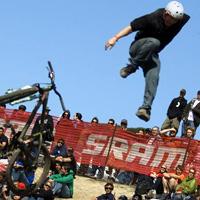
Recently on Cyclingnews.com |
Tech feature: A discussion of the SRAM - Lehman Bros deal, September 20, 2008
Will SRAM's deal with Lehman Brothers stick?
By Gary Boulanger, US editor - Bikeradar.com

|
BikeRadar spoke with SRAM co-founder and president Stan Day on the eve of Interbike about what may happen in light of the Lehman's situation, and the prospect of working with Lance Armstrong if the Texan joins the SRAM Red-sponsored Team Astana for 2009.
SRAM began 20 years ago with six employees, making and selling a twist shifter for multi-sport athletes and road racers. Now, with 2,500 employees worldwide and a brand portfolio that includes RockShox, Zipp, Avid and TruVativ, the company that recently re-entered the high-end road market with its Red, Force and Rival gruppos is answering questions about its relationship with Lehman Brothers, which is embroiled in bankruptcy proceedings.
Recently, Chicago-based SRAM announced it was taking on an investment partner, Lehman Brothers, to grow the company beyond its US$500 million annual sales.
Despite the grim news about Lehman Brothers Holdings declaring bankruptcy recently, Day has said it may or may not affect the equity buy-out with SRAM. If SRAM has the resources to forgo the financial partnership, the question is: 'why get involved with a partner at all'?
"Lehman Brothers Merchant Banking (LBMB) is still open for business, with 40 employees and US$8 billion under management. The fact that Lehman Brothers Holdings is in bankruptcy is a distraction, and certainly not good for their brand, but LBMB is safe, secure and separate," Day told BikeRadar from his Chicago office. "We didn't have to seek a partner; it's all part of the long-term plan. One of the things we wanted to do as we pass the US$500 million sales mark this year is work with a company with the experience to grow a company like ours to the next level. When we started SRAM 20 years ago it was just six of us. We didn't have any experience running a company back then."
Day knows that having outside experience will help SRAM stay on track to grow the company as he and his long-time management team see fit. He is steadfast in his belief that this is the right time to take on a financial partner, despite the major headlines declaring otherwise.
"It's our belief and LBMB's belief the deal will be completed per schedule early October," Day added. "If for some reason the financial meltdown continues, SRAM won't be impacted if the deal falls through. We just won't be able to add this outside investor as part of our long-range plan."
The bike industry has shown its strengths and weaknesses regarding mergers, buy-outs and financial partnerships. Cannondale and RockShox famously failed after going public (SRAM purchased RockShox in 2002), while Schwinn, GT, Mongoose and Cannondale were all absorbed by Pacific Cycle. Trek is privately held, and built its brand war chest by acquiring Bontrager, Gary Fisher, LeMond , Klein, Icon and Rolf over the years; only Bontrager and Fisher have held strong for the Wisconsin manufacturer. Doesn't Day think selling a 40-percent stake in SRAM would compromise the company's independent, entrepreneurial spirit?
"First, our senior management team stays intact, with me at the helm," he said. "There'll be no change. Secondly, the people investing don't know the bike industry like we do. They know financial markets, how companies grow from US$500 million in sales to something larger; that's their experience base. I still think we'll be able to make sound decisions as always."

|
Day explained SRAM's process of selecting an investor, doing its due diligence with in-depth interviews with 20 prospects. Out of that group SRAM and his management team felt most comfortable with the philosophy of LBMB.
"This is not a shot-gun marriage; this has been a deliberate process that has taken six months," he added. "We've shared our views, they've shared theirs. We'll maintain our decision-making and product development as usual."
As a company famous for strategic acquisitions to try and stay one step ahead of Shimano, its biggest arch rival, SRAM knows the well may have run dry, but is open to adding new technology whenever possible to fill the gaps in its current portfolio. Indianapolis-based Zipp was added exactly one year ago.
"We've completed our major strategic acquisitions," Day said, "and we may add a product line or new technology, maybe even a key supplier, but there's nothing big on my radar. Small acquisitions can be very important. We'd be open to add technologies to the company that compliment our existing brands."
The success of SRAM's re-entry into the road market has paid off handsomely in the form of Grand Tour success with Team Astana, who race on SRAM Red-equipped Trek Madones. Now, with the news of Lance Armstrong returning to the pro peloton in 2009, there's a grand assumption it'll be with Johan Bruyneel's Team Astana. Armstrong has ridden Trek since 1998, but has been a Shimano-sponsored athlete his entire career. Day is pretty excited about the prospect of working with Armstrong, although at this point it's pure speculation until Armstrong announces his plans at the Clinton Global Initiative in New York City September 24.
"If Lance wanted an executive to train with, I'd be willing," Day said, "but he may need to find someone more capable than me! I commute to our downtown Chicago office every day. I also like to ride mountain bikes in the Northwoods of upper Michigan. Road riding is difficult in downtown Chicago, so it's a little more challenging. It's safer to put the bike on the car and drive an hour to get out of rush-hour traffic!"

